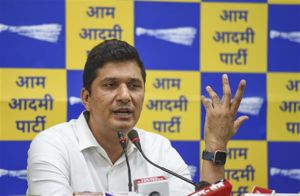
Arteev Sharma
Tribune News Service
Jammu, September 27
While India is exploring the option to maximise its share of river waters by increasing the use of the rivers flowing through Jammu and Kashmir, all mega power projects — both in the state and Central sectors --- on rivers falling under the Indus Water Treaty (IWT) continue to hang fire.
The sluggish pace of harnessing the hydropower potential of Jammu and Kashmir could be gauged from the fact that only 3,263.46 MW, which is around 19.80 per cent of the identified 16,475 MW potential of the state, has been exploited so far. This comprises 11,283 MW in the Chenab basin, 3,084 MW in the Jhelum basin, 500 MW in the Ravi basin and 1,608 MW in the Indus basin.
Of the identified power potential, nearly 1,211.96 MW has been identified in the state sector from 21 power projects, 2,009 MW in the Central sector from seven projects and 42.5 MW in the private sector from four projects. The estimated hydropower potential of the state is 20,000 MW.
Under the IWT, India has control over three eastern rivers --- Beas, Ravi and Sutlej --- all flowing from Punjab while Pakistan controls the western rivers Indus, Chenab and Jhelum which flow from Jammu and Kashmir. The state has been demanding a review of the treaty as it deprives it of its rights to use the water of the rivers.
Official sources said all mega projects, which were envisaged to exploit cent per cent hydroelectric potential of the state and ensure round-the-clock electricity supply to the people, on the Chenab, Indus, Jhelum and Ravi were either being executed at a snail’s pace or work on them was yet to be undertaken despite lapse of many years.
“The 850 MW Rattle project on the Chenab in Kishtwar district was abandoned by the executing agency following a dispute with locals. Several other projects are waiting to see the light of day are 1,200 MW Sawalkote, 660 MW Kiru, 800 MW Bursar, 390 MW Kirthai-I, 930 MW Kithai-II, 48 MW Lower Kalnai in Kishtwar, 560 MW Kawar. All these projects are at the basin of the Chenab. The 280-MW Ujh is on the Ravi,” a source said.
Sources said the Kishanganga (330 MW) hydroelectric project at Gurez in Bandipora district on the Jhelum, which was announced almost a decade ago, was in the advanced stage of construction, while the detailed project report of the Bursar hydroelectric project (800 MW) in Kishtwar was being prepared.
Another mega project, the 1,000-MW Pakal Dul hydroelectric power project on a tributary of the Chenab in Kishtwar was also hanging in the balance because the Chenab Valley Power Projects Limited, which was to execute the project, had cancelled the tenders in February this year. The tenders were invited in 2011.
Sources said the state government had been facing “resource crunch” to execute the projects under the state sector, while the projects under the Central sector also faced “inordinate delay” on varied reasons --- both administrative and technical.
“Projects of installing capacity of 2,964 MW are under various stages of clearance. They include a 1,000- MW project which has received all clearances and the construction on it is about to commence,” the National Hydroelectric Power Corporation said in a statement recently.
Dheeraj Gupta, Commissioner Secretary, Power Development Department, attributed the “inordinate delay” in execution of all mega power projects to “administrative and technical issues”.
“There are several issues which impact the execution of power projects in the state. We have the funding issue apart from the administrative and technical glitches. Besides the long wait for clearance from the IWT. We have recently got clearance for the Kiru power project. We are doing our best to ensure early execution of power projects,” Gupta added.
After the Uri attack in which 18 soldiers were killed, India, under the diplomatic exercise to concern Pakistan, has laid thrust on reviewing the Indus Water Treaty which was signed in 1960. The treaty is considered among the most liberal water-sharing pacts in the world and has survived three wars.
20,000 MW estimated potential
* The sluggish pace of harnessing the hydropower potential of Jammu and Kashmir could be gauged from the fact that only 3,263.46 MW, which is around 19.80 per cent of the identified 16,475 MW potential of the state, has been exploited so far
* Of the identified power potential, nearly 1,211.96 MW has been identified in the state sector from 21 power projects, 2,009 MW in the Central sector from seven projects and 42.5 MW in the private sector from four projects. The estimated hydropower potential of the state is 20,000 MW



























